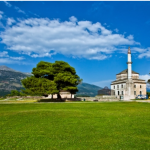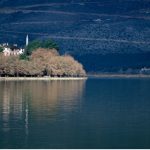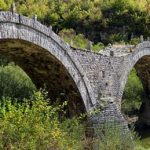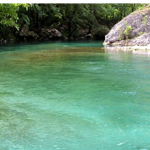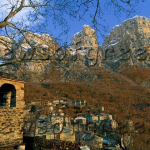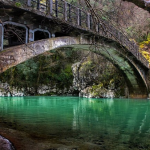By Niki Argirou-Kolotourou (B class)
Traditional architecture, rich history, urban culture and youthful energy, all make for a unique combination that transforms the city on the shores of tranquil LakePamvotida into an ideal choice for relaxation, exploration and entertainment.
Ioannina is blessed with abundant natural beauty and a rich history. Lake Pamvotida lies at the foot of mountain Mitsikeli. The lake is just so peaceful, you can either follow its romantic promenade or sit on a bench and take in the view. Small boats connect the city with a little island in the middle of the lake, the so-called “nissaki” by the locals. This islet counts around 100 stone houses and numerous tiny stone alleys – a beautiful labyrinth of history and architecture. Here you can also visit the house where Ali Pasha, the ruler of Ioannina during the years of Othoman occupation was assassinated.
Another must- see is the old town, spreading within the walls of the city castle, the largest Byzantine fortress in Greece which offers breathtalking views over Lake Pamvotida.
If you have one museum to visit this should be the Museum of Greek History. Its creator Pavlos Vrellis, a former algebra teacher and sculptor, bought the land ath the age of 60, designed the building that houses now the museum and built everything from scratch. The interior, consisted of dimly lit rock-encased areas, hosts 36 wax sculptures created by Pavlos Vrellis depicting various landmarks of modern Greek history.
Last, make sure you visit Perama Cave. Follow the guited tour trough the cave and admire up close the beautiful stalactites and stalagmites that have been formed over the years.
Ioannina is famous for its silverwork. There are numerous shops around the city selling silver jewellery and decorative items-the perfect gifts for yourself or your loved ones.
Visiting Zagori, northwestern Greece is something of an otherworldly experience. Perched at altitudes as high as 1.400metres, the region’s villages, inhabited for centuries and truly incomparable, constitute a surprisingly functional society that has lived, prospered, and continues to live as one with nature. Man-made constructions are an integral part of the setting, andappear to have grown or evolved along with the natural landscape. The region’s contact with the outside worldwas assured by a network of tracks and 45 stone arch bridges, works of architectural wonder and most of which were constructed in the 18th and 19th centuries. These days, the trails offervisitors the opportunity to embark on unique trekking experiences.
The best way to explore Zagori is via a route beginning at Kapesovo, along trails that have existed for centuries, through villages, along rivers, across bridges, taking in landscapes of sensational beauty and ending up at Koukouli. This route takes about a week,but if your time schedule doesn’t allow for that, pick asection and spend a couple of hours or an afternoon taking in this marvelous part of the country.
The route from Kapesovo to Vradeto includes the stairs of Vradeto, an 18th century stone-paved trail along the side of the gorge. Heading off from Kapesovo and Koukouli and crossing the renowned Kokkori Bridge leads to Kipous, where the Plakida Bridge,one of very fewtriple-arch constructionsin the area, is located. From here, continue to Dilofo, the best preserved of all the region’s villages which offers spectacular views. The Vikos Gorge, listed by the Guinness Book of World Records as the world’s deepest, begins at Vitsa. Walking the whole gorge from start to finish takesfive-and a –half to six hours. At the end you’ll find the village of Papigo. The gorgeous nearby Rogovo pools, ideal for swimming in the summer, are definitely worth a visit. Heading all the way up to the mountain retreat at Astraka and Drakolimni lake, at an altitude of 2.050 metres ,is a magical experience.The view from the lake is breathtaking. Once rested at the retreat, hikers can take in the Astraka highlands and head towards Tsepelovo before concluding the trek at Koukouli.

